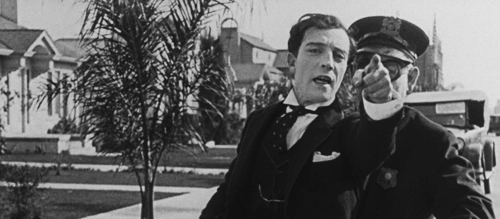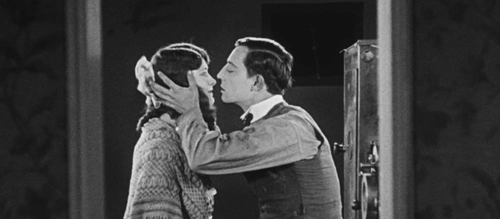‘Sherlock Jr.’ at 100 – Review

Sherlock Jr. (1924)
Director: Buster Keaton
Screenwriters: Clyde Bruckman, Jean Havez, Joseph A. Mitchell
Starring: Buster Keaton, Kathryn McGuire, Ward Crane
Somehow a century has passed since the inimitable Buster Keaton unleashed one of his best films upon the world. One of the three greats of silent slapstick (along with Charlie Chaplin and Harold Lloyd), Keaton was responsible for some of the best films of the silent era, along with a great many of the best stunts ever put to film. Only partially is this due to most of them being done for real, something which would never get past health and safety in today’s world. You only have to look at Our Hospitality a few years later in 1926 (UK release) to see, just for a few examples, both his waterfall rope swing and house frame drop stunts, and how they were the product of a time when people went above and beyond, putting their personal safety in the firing line, to get a laugh. Never again will we have a showman willing to put his life on the line in such a way, nor a world that will allow what was, realistically, extreme stupidity.
But Keaton also cared deeply about his storytelling and the reception of his films, most of which he directed himself. He made several cuts to Sherlock Jr after screenings didn’t go the way he wanted, each to try and get the laughs he needed. And whilst critics of the time didn’t seem to think as much of the film, it is now regarded as a masterpiece. In 1990, it was entered into the Library of Congress for preservation. It has made numerous lists of best stunts, laughs, scenes, films, etc. It is one of the best by one of the best.
Describing the plot for those who haven’t seen it is tricky. Initially, Sherlock Jr. is about Buster Keaton’s projectionist, studying to be a famous sleuth from his book “How to Be a Detective” in his spare time. He manages to swindle through some gags to get enough money to buy a present for his sweetheart (Kathryn McGuire), not knowing that the villain of the piece (Ward Crane) has framed him for the theft of a watch to try and win McGuire over.
Keaton then returns to work at the movie theatre, falling asleep and entering a dreamworld, jumping in and out of the film screen, becoming the world famous detective, Sherlock Jr, chasing after villains through death-defying stunts, in a strange but amusing display of daydreaming for aspirations the projectionist character will never reach, defeating the criminal and getting the girl.
The stunts (which are what many go to Keaton for) are all here, in all their iconic and glorious splendour even 100 years later. From a train-top chase (which resulted in Keaton having his neck slammed against a steel rail under the pressure of a waterspout in one take, breaking his neck, something not spotted for nine years) to a jump down a train-crossing barrier, to the collapsing car, and the run on the bicycle in front of the train and over the roofs of trucks; these moments aren’t just great for the time, they are some of the most impressive action moments ever put to film. Keaton’s deadpan expression and trademark blasé attitude to the chaos around him gives these moments the casual air of accident that make them all the more impressive. Even the smaller moments, such as a suitcase jump, and an exploding pool-ball scene, are expertly set up, combining special effects, perfect acting, and timing in equal measure.

The first half of the film is admittedly weaker than the second, in that it needs to set everything up for us to get to the effects-laden extravaganza of part two. Despite this, it still has Keaton’s projectionist endearing the audience with his lovesick attempts to win his girl over, with some nice subtle moments of slight humour in the parlour. It’s not bad, but it’s the second half that really brings the film alive.
It has been noted by modern critics that Buster Keaton’s use of the cinema to express the character’s innermost desires is far beyond its time, a kind of postmodernist breaking of reality barriers. He uses the medium itself, that of film, to experience a new reality, one with no sense of correctness. Keaton himself stated in interviews that a scene involving walking into the cinema screen, whereupon the scene would comically keep changing location for him, causing trips and pratfalls and stumbles, was the whole reason for the film in the first place. The film therefore takes on a metatextual meaning, a kind of Keaton-ception, the character he plays being an avatar for himself, putting himself on a screen, on a screen. He takes control of the chaos of the scene-changes and becomes the great hero of the film.
Sherlock Jr therefore becomes an interesting artefact of the time, not only for how film stars presented themselves, but how films were beginning to interact with their own medium, finding new ways to express ideas about the stories they were telling. With film being very much likened to ghostliness, the dead remaining able to talk and walk long after departing, it is interesting that Keaton’s projectionist enters this new cinematic world after falling asleep and splitting from his body in a ghostly double-exposure trick. Sherlock Jr is as much about film’s ability to manipulate and understand the world around it as anything else, evidenced by the final scene where Keaton moves in for a kiss for his sweetheart (after she’s forgiven him and apologised for incorrect accusations of theft) in a mimic of the film he’s projecting on-screen at that moment – surprisingly sophisticated for a century-old comedy film. And, of course, it’s got some of the best action moments in cinema.
So what if the first fifteen minutes aren’t as ludicrous as the last half an hour? They’re still good fun, and combine with the second half to bring us an incredible, intriguing, and important 45 minutes of film.
Score: 20/24

